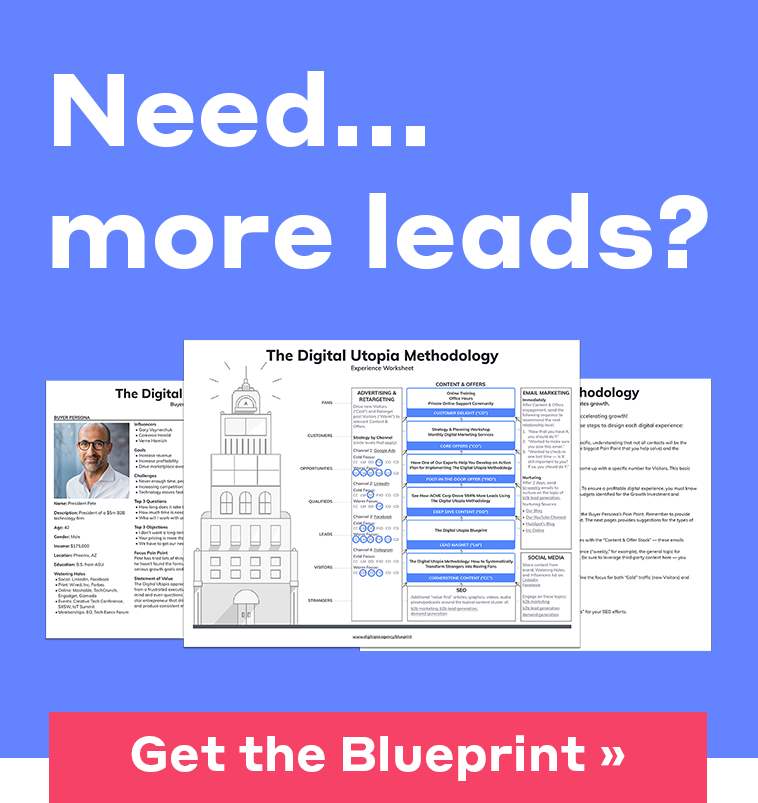The 10 Commandments of HubSpot Marketing Hub
by Frank Cowell | Updated Jun 5, 2025
While HubSpot Marketing Hub is, hands-down, one of the most amazing marketing platforms, I’m regularly amazed at the sins that are committed everyday by customers of this platform. These sins are sometimes tactical, but, more often than not, are the result of strategic misalignment. The net result is that many invest in the platform and then later become frustrated that they aren’t getting more out of it. And by “more,” we’re talking about leads and sales opportunities.
Because I come across this so often, I decided to develop a “10 commandments” of HubSpot Marketing Automation Hub so that I can help others that wish they could get more from their investment.
Discover the blueprint that turns HubSpot into a growth-generating machine »
The 10 Commandments of HubSpot Marketing Hub
1. Thou shall not attempt to have HubSpot Marketing Hub do the job of sales
Easily, the number one sin I see committed is the application of marketing tech in a business where the number of deals required to “knock it out of the park” is, relatively, small. For example, if you only need a handful of deals per month to achieve your growth objectives, then the development of elaborate automated nurturing workflows isn’t going to be that beneficial.
With a small volume of leads, you’re better off manually digging into each lead and customizing personal, 1-to-1 follow-up. This manual follow-up on a small lead volume will be more effective because your sales team will only work the leads that match your ideal customer profile. Additionally, this 1-to-1 follow-up will provide crucial marketplace feedback that will inform the future content and offers that you develop.
Let your sales team sell and only implement marketing automation after the lead volume exceeds your team’s ability to follow-up manually!
2. Thou shall leverage third-party content
When you are ready to employ automated nurturing workflows, you must take into consideration the length of your buying cycle. In many considered sales cycle businesses, the buying cycles can be very long, which means that your nurturing sequences need to be equally long (if not longer!). That said, I rarely see organizations deploy deep, robust automated nurturing workflows because they get overwhelmed with how much content needs to be developed.
Fortunately, there’s a secret that will allow you to deploy deep nurturing workflows with a fraction of the work!
The secret?
Leverage third-party content!
Remember, once you have the lead in your database, your job is to provide them value. And the best way to do that is to curate content from non-competitive resources—YouTube, trade publications, etc. Once they are in your database, you have them, so you don’t have to worry about “losing them.” Focus on curating content that reinforces messages that align with your cornerstone content, inspires change, and educates.
3. Thou shall not get paralyzed
It’s really easy to be overwhelmed by all of this stuff. The volume of information and moving parts are crazy.
But remember—effective marketing is about momentum, not perfection!
The very best thing you can do is simply get started. If you don’t know where to start, simply write down every single question your sales team hears from prospects and develop a post for each question. Don’t think about it—just answer the question and publish it. It won’t seem like much, but once you are in a rhythm, things will start to snowball.
Don’t think. Just start. Keep moving.
4. Thou shall start narrow
Your marketing programs should start with one buyer persona and one pain point.
I get it—you have several buyer personas, each with multiple pain points, and you want to make sure every single one is addressed so you don’t have any gaps in your content plan. Oh, and your executive team doesn’t understand what you do, so they are going to freak-out, too, if they hear there are buyer personas not being addressed in the content plan.
And as I mentioned above—it’s paralyzing.
As with Commandment #3, the best thing you can do is start. And when you do, start narrow. Not only will this allow you to maintain your sanity, it’s actually the more strategic approach to marketing. The best digital experiences are those that are hyper-focused on one buyer persona and one pain point. In this way, you end-up with a digital ecosystem that’s comprised of several digital experiences, each one specifically designed to solve one problem for one person.
5. Thou shall dive deep before going wide
Piggybacking off of Commandment #4, with one narrow focus, go as deep as you possibly can so no other brand on the planet outdoes you when it comes to content that solves this one pain point for your one buyer persona. Be the authority. If you are following #4 you will actually have the bandwidth needed to achieve this objective.
With this kind of focus, you and your team will have something very specific to rally around. Everyone will know exactly who they serve and how. Ultimately, this makes it easier to create momentum (which is more important than perfection, in case you haven’t heard).
Discover the blueprint that turns HubSpot into a growth-generating machine »
6. Thou shall be human
News flash: people don’t develop relationships with logos—they develop relationships with other people.
OK, I realize that sounds a bit condescending, but it’s, honestly, a sin that I still see committed all too often. Companies engage and nurture their leads with fancy templates and corporate speak instead of connecting in a real, human manner.
In your follow-up and nurturing emails, aim for “plain”—no logos or “newsletter” layouts. If you want to do a newsletter, by all means, go ahead, but your follow-up and automation emails should be personal in nature, sent from a real, human email address that people can reply to.
Write as if you were writing to a business associate—be human and have fun!
7. Thou shall provide value in advance
Let’s face it—not everyone is a “ready now” lead. In fact, the majority of your leads aren’t ready now. If your only CTA (call to action) is Get a Quote or Request a Consultation, you will miss a massive opportunity to engage people early in their buying journey.
To effectively engage early, you have to provide value in advance. This requires obsessing over Commandments #4 and #5, which means going narrow and deep. When you do this, you’ll develop information, tools, and resources that are so valuable they could garner revenue unto themselves. You will have spent the time to truly serve your lead as if they were already your customer.
Think: what tools and resources will empower your buyer persona to take real action on their pain point? Create that.
8. Thou shall align the marketing and sales teams
Nothing will kill an inbound digital marketing program faster than a Sales team that has no interest in the work or leads that marketing is producing. It’s imperative for Marketing and Sales to get on the same page, once and for all!
How do you do that? Here are four tips:
1. Agree on lifecycles terminology. Both teams should have crystal clear definitions for each lifecycle stage, especially the MQL (marketing qualified lead).
2. Establish an SLA. Once the lifecycles and definitions are agreed-upon, establish an SLA (service level agreement) between the two teams. Marketing agrees to generate a certain number of MQLs per month, and Sales agrees to convert a certain percentage of MQLs to Customers each month.
3. Create a “smarketing” scorecard. Your new SLA won’t do much good if you aren’t measuring the agreed-upon and indicator metrics on a regular basis. Each team should review this scorecard in their separate weekly meetings.
4. Hold a monthly “smarketing” meeting. Once per month, the two teams should meet and talk about what worked, what didn’t work, marketplace feedback, etc. Document and hold each other accountable to action items that come out of the meeting.
9. Thou shall create a relationship-driven journey
As digital marketers, we often forget that the “clicks and ticks” are actual people, real humans. And real humans go through natural relationship “levels.” It’s not binary—“customer” and “not a customer.”
Take a look at your funnel: did you architect a journey that acknowledges where your buyer persona is in relationship with your brand? As marketers, we often talk about “buyer journeys,” but we ignore the fact that they are on a relationship journey with our brands, and this relationship journey has a progression just like any other human relationship.
Your content and offer funnel must align with this relationship progression and infuse relationship psychology so that moving from one relationship level to the next is natural and logical for your buyer personas.
10. Thou shall optimize from the top, down
In any system, improving the flow from one function to the next will always yield higher output without increasing the input.
Why is this important?
Because when output (customers) increases without increasing the input (traffic), your ROI increases because your investment (the acquisition of traffic, which is the input) stayed the same.
With that understanding, start from the last function in the system (what I call the “top”) and work your way down until you find the most significant bottleneck. That bottleneck is where you should deploy a bulk of your attention and effort.
In relationship terms where “customers” and “fans” are of the highest relationship level (therefore living at the “top”), this means that “top-down optimization” is when you start with the question: Are we elevating customers to fans in a significant way?. If the answer is a resounding “no,” then that’s where you start. If the answer is “yes,” then go one level down and ask the same type of question: Are we elevating opportunities to customers in a significant way?. This is another way of asking “What is our opportunity-to-customer conversion rate and how does that fare against our target?”
The emphasis is on “elevating relationships.”
Why?
Because it takes the lens that if the conversion rate is off, then the reason is that you’re not providing enough value to make that relationship progression a natural, logical step for your prospect. This lens forces you to obsess on value, not sales tactics.
Just Remember....
The HubSpot Marketing Hub is just like any tool, when used by a focused and experienced hand it should streamline the process and deliver ROI.
If you're intrigued by the HubSpot Marketing Hub strategy shared, then you'll want to download the blueprint below. It's yours for the taking:









